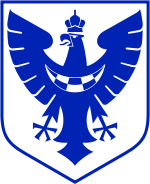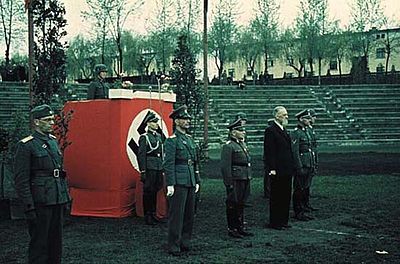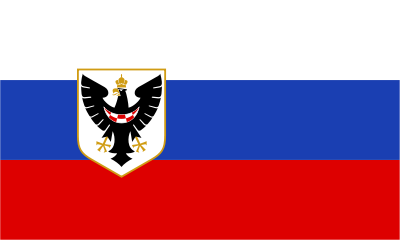- Slovene Home Guard
-
Slovene Home Guard 
The sign of Slovene Home GuardActive 1943 - 1945 Country Slovenia Size about 15.000 Motto Za boga, narod in domovino
"For God, Nation and Homeland"March Naprej zastava slave
Forward, Flag of GloryCommanders Notable
commandersLeon Rupnik
Vuk Rupnik
Ernest Peterlin
Franc KrennerThe Slovene Home Guard (Slovene: Slovensko domobranstvo; German: Slowenische Landeswehr), SD for short, was a World War II Slovenian anti-communist collaborationist militia[1] that fought mainly against the Slovenian partisan resistance. It was sponsored and armed by the Nazi German forces in Slovenia, and served as an auxiliary anti-guerrilla unit under German command in the Nazi-occupied the Province of Ljubljana between late September 1943 and early May 1945. Most of its membership was executed by Yugoslavia's communist authorities after the end of the war, in May and June 1945.
Although officially under direct German command and without any political autonomy, the SD was closely linked to Slovenian anti-Communist parties and organizations, which provided most of the membership.
In the Slovenian Littoral, a similar but much smaller unit, called Slovenian National Defense Corps (Slovene: Slovensko narodno varnostni zbor, German: Slowenisches Nationales Schutzkorps), more commonly known as the Littoral Home Guard (Slovene: Primorsko domobranstvo) was ideologically and organizationally linked to the SD. An even smaller Upper Carniolan Self-Defense (Slovene: Gorenjska samozaščita, German: Oberkrainer Landschutz), also known as Upper Carniolan Home Guard (Slovene: Gorenjsko domobranstvo) was active in Upper Carniola between 1944 and 1945. All three "home guard" units were formed almost exclusively by ethnic Slovenes. At their peak, they had a combined membership of around 21.000 men, of whom 15.000 in the Province of Ljubljana, 3.500 in the Julian March and 2.500 in Upper Carniola.
Contents
Background
Slovenia was the northernmost part of Yugoslavia and, after the invasion of Yugoslavia, Slovenian territory was divided between the Third Reich, which annexed Lower Styria, Upper Carniola, Slovenian Carinthia and the Posavje, the Italy which annexed south-east Slovenia with Ljubljana, and Hungary which annexed Prekmurje.
Formation
On 24 September 1943, the SD was formed by order of SS General Rösener.[2] Rösener awarded service and combat medals to the members of the SD.[3] An individual member of the SD was a Domobranec, the plural of which was Domobranci. In its aims and ideology, the SD was anti-Partisan and anti-communist.
The Slovene Home Guard (SD) functioned like most collaborationist forces in Axis-occupied Europe during World War II, but had limited autonomy, and at first functioning as an auxiliary police force that assisted the Germans in anti-Partisan actions. Later, it gained more autonomy and conducted most of the anti-Partisan operations in Slovenia, while still having German officers in command. The SD supported their military actions by publishing a regular newspaper and pamphlets.
The majority of the SD forces were infantry, although they also possessed artillery units, which were, however, seldom used. The SD had no armoured units (except for a few armoured trains), even though several tank crews were sent to Germany for training. The SD used Italian equipment (confiscated when Italy dropped out of the war in September 1943), and weapons, uniforms and equipment supplied by the Germans, especially later in the war.[4]
Almost all SD members fled Slovenia and took refuge in the Southern Austrian province of Carinthia at the end of the war (May 1945). Most were returned to Yugoslavia by the British military administration, and many were executed by the new communist authorities.[5][6] The total number of Domobranci summarily executed in mass executions by the authorities exceeds 11,400.[7]
The Slovenian Government created the Commission on Concealed Mass Graves in Slovenia and documented the mass grave sites of the POWs. They were investigated between November 2005 and October 2009. The POWs units that were not executed were placed in Yugoslav concentration camps.[8]
In what became known as the "Zaliv Affair", in 1975 the summary executions were publicly condemned by the Slovene poet Edvard Kocbek, resulting in a campaign by the Belgrade government against Kocbek's works.
Oaths of allegiance
 The Domobranstvo oath-taking ceremony at Ljubljana central stadium 20 April 1944. The bearded man in civilian clothes is Domobranci leader Leon Rupnik. To his left is Erwin Rösener.
The Domobranstvo oath-taking ceremony at Ljubljana central stadium 20 April 1944. The bearded man in civilian clothes is Domobranci leader Leon Rupnik. To his left is Erwin Rösener.
Domobranci swore oaths of allegiance at Bežigrad stadium, first on Hitler's birthday, 20 April 1944, and the second time on 30 January 1945, the 12th anniversary of the Nazi takeover of power in Germany. In the first ceremony, the Domobranci from Ljubljana, some other units from the province of Ljubljana, and members of the police corps of the Slovenian Home Guard swore oaths of allegiance. Before the oath, the bishop Gregorij Rožman held a silent mass for the Domobranci, then, according to witnesses, chose to observe from the background despite being offered a place on the main stand, and left quickly afterwards.[9]
During the oath ceremony, the president of the provincial government, Leon Rupnik, and SS general Erwin Rösener made speeches and there were also some guests present, including the honorary consul of the Independent State of Croatia, commissioned officers of the Slovenian Home Guard, the rector of the Slovenian Academy of Sciences and Arts and others. They flew the German and also, for the first time since the beginning of the occupation, the Slovenian flag (which was banned under the Italian occupation), and displayed the coat of arms of Carniola. First they played the Nazi anthem and the Slovenian anthem Naprej zastava slave.[10] After the ceremony Rösener awarded Domobranci medals and wound badges.[11]
The Littoral and Upper Carniolan units never swore oaths.
Members of the Domobranci and the police force promised that:
“ ”I swear by almighty God that I will be loyal, brave and obedient to my superiors, that I will stand in common struggle with the German armed forces, which stand under the command of the leader of Greater Germany, SS troops and police against bandits and communism and their allies; this duty I will carry out conscientiously for my Slovenian homeland as part of a free Europe. For this struggle I am also ready to sacrifice my life. So help me God!”[12] ” Every Domobranec also signed a written statement in German and Slovene that:
“ ”I have entered into the Slovensko Domobranstvo voluntarily, into the battle and the destruction of communism that has already brought sorrow to my country and endangered all of Europe. My fixed resolve with all its might is to fight under German leadership to the satisfaction of my country and Europe and to this I devote my life. I have confirmed this commitment by holy oath today. I have been informed as to my duties and rights regarding service, discipline and payment.”[13] ” Literature
- Mlakar, Boris; Kokoalj Kočevar, Monika; Martinčič, Vanja; Tomc, Gregor (1999) (in Slovenian). Mati, Domovina, Bog : [zbornik]. Ljubljana: Muzej novejše zgodovine. ISBN 961-90232-4-2.
- Mlakar, Boris (2003) (in Slovenian). Slovensko domobranstvo : 1943-1945. Ljubljana: Slovenska matica. ISBN 961-213-114-7.
- Nose, Aleš (2008) (in Slovenian). Domobranci zdravo - Bog daj. Ljubljana: Modrijan. ISBN 978-961-241-223-4.
- Kladnik, Tomaž (2006) (in Slovenian). Slovenska partizanska in domobranska vojska. Ljubljana: Defensor. ISBN 978-961-6177-11-5.
- Munoz, Antonio J. Slovenian Axis Forces in World War II 1941-1945. Bayside, New York.
See also
- Province of Ljubljana
- Yugoslavia during the Second World War
- Collaboration during World War II
- Franc Frakelj
- Gregorij Rožman
- Erwin Rösener
- Leon Rupnik
- Ljenko Urbančič
- Liberation Front of the Slovenian People
- Kingdom of Yugoslavia
- Yugoslav Army in the Fatherland (Jugoslovenska vojska u otadžbini, or JVUO), or Chetniks
References
- ^ http://upload8.postimage.org/666268/domobranskazastavainhakenkrajc.jpg
- ^ In his speech at the ceremony on 20 April 1944 Rösener said
"On 24 September 1943 I issued the command for the foundation of Slovensko domobranstvo. From the few troops of the so-called White Guard legionnaires, as per my order, Slovensko domobranstvo has grown. With the help of the Greater German Reich, we have trained, clothed and armed you. Today you have taken an oath, that you will, together with the German Army, the military SS and police fight for the freedom of all of Europe”. Slovenec newspaper, 21 April 1944. - ^ Erwin Rösener giving combat medals to Domobranci: http://img266.imageshack.us/img266/5913/heimwehrrsnerri6.jpg
- ^ In his speech at the ceremony on 20 April 1944 Rösener said
"With the help of the Greater German Reich, we have trained, clothed and armed you”. Slovenec newspaper, 21 April 1944. See
http://www2.arnes.si/~ljgozzb1/javnost17.htm - ^ Encyclopaedia Britannica: Slovenia (Word War Two)
- After the armistice the British repatriated more than 10,000 Slovene collaborators who had attempted to retreat with the Germans, and Tito had most of them massacred at the infamous “Pits of Kočevje.”
- ^ www.enotes.com "Yugoslavia." Genocide and Crimes Against Humanity. Ed. Dinah L. Shelton. Gale Cengage, 2005. eNotes.com. 2006. 26 Jun, 2010 Yugoslavia: Genocide & Crimes Against Humanity-Mark Thompson.
- The killing continued after the war, as Tito's victorious forces took revenge on their real and perceived enemies. British forces in Austria turned back tens of thousands of fleeing Yugoslavs. Estimates range from 30,000 to 55,000 killed between spring and autumn 1945.
- ^ The massacre that haunts Slovenia: how Britain betrayed unarmed Slovenians to communist Peopeles Army
- ^ European Public Hearing on "Crimes Committed by Totalitarian Regimes” Slovenian Presidency of the Council of the European Union (January–June 2008) and the European Commission. Chapter: Mass killings without court trials. Pages 163-165.
- Chapter section: " When the British military forces returned in the second half of May 1945, the captured Slovenian home guards and members of military formations from other parts of Yugoslavia and civilian refugees to Slovenia, the Slovenian authorities interned them in concentration camps in Teharje, St. Vid nad Ljubljano, Skofja Loka and Kranj ".
- ^ Dolinar, France M. (1996). "Sodni proces proti ljubljanskemu škofu dr. Gregoriju Rožmanu od 21. do 30. avgusta 1946 (3. del)". Zgodovinski časopis 50 (3): 415. http://www.sistory.si/publikacije/pdf/zcasopis/ZGODOVINSKI_CASOPIS_LETO_1996_LETNIK_50_STEVILKA_3.pdf.
- ^ Griesser - Perčar, Tamara (2004). Razdvojeni narod. Ljubljana: Mladinska knjiga. ISBN 86-11-16799-6.
- ^ Mlakar, Boris; Kokoalj Kočevar, Monika; Martinčič, Vanja; Tomc, Gregor (1999). Mati, Domovina, Bog : [zbornik]. Ljubljana: Muzej novejše zgodovine. ISBN 961-90232-4-2.
- ^ "Domobranska prisega«, Slovenec, Jutro, 21. april 1944; 31. januar 1945.
- ^ Slovenec newspaper, 21 April 1944.
Collaborationism in Yugoslavia Collaborationist states Political organizations Collaborators Military organizations Military Administration in SerbiaWhite Guards · Slovene Home Guard · Legion of Death · Upper Carniola Home Guard · Slovene National Security Force · Anti-Communist Volunteer MilitiaSee also: Yugoslav Front · Invasion of Yugoslavia Categories:- History of Slovenia
- Collaboration during World War II
- Slovenian Nazi collaborators
Wikimedia Foundation. 2010.

